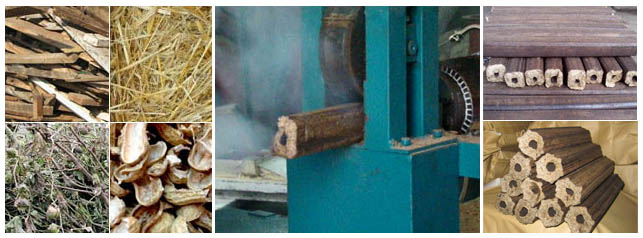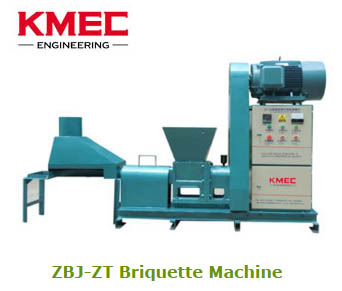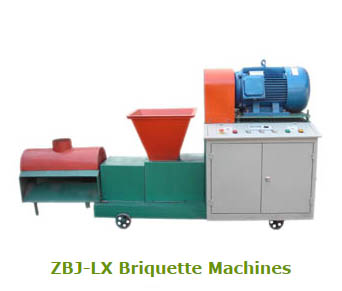Characteristics of Biomass briquetting and Their Significance
In order to produce good quality briquettes, feed preparation is very important. Feed parameters are discussed in this section, as these play a practicable role in biomass technology.
For biomass briquetting, it is important to know the feed parameters that influence the extrusion process. For different
briquette machines, the required parameters of raw materials like their particle size, moisture content and temperature are different. These are discussed below.

Effect of particle size
Particle size and shape are of great importance for biomass densification. It is generally agreed that biomass material of 6-8 mm size with 10-20% powdery component (< 4 mesh) gives the best results. Although the screw extruder which employs high pressure (100 0 - 1500 bar), is capable of material of oversized particles, the will not be smooth and clogging might take place at the entrance of the die resulting in jamming of the machine. The larger particles which are not conveyed through the screw start accumulating at the entry point and the steam produced due to high temperature (due to rotation of screw, heat conducted from the die and also if the material is preheated) inside the barrel of the machine starts condensing on fresh12 cold feed resulting in the formation of lumps and leads to jamming. That is why the processing conditions should be changed to suit the requirements of each particular biomass. Therefore, it is desirable to crush larger particles to get a random distribution of particle size so that an adequate amount of sufficiently small particles is present for embedding into the larger particles. The presence of different size particles improves the packing dynamics and also contributes to high static strength. Only fine and powdered particles of size less than 1 mm are not suitable for a screw extruder because they are less dense, more cohesive, non-free flowing entities.
Effect of moisture
The percentage of moisture in the feed biomass to extruder machine is a very critical factor. In general, it has been found that when the feed moisture content is 8-10%, the briquettes will have 6-8% moisture. At this moisture content, the briquettes are strong and free of cracks and the process is smooth. But when the moisture content is more than 10%, the briquettes are poor and weak and the operation is erratic. Excess steam is produced at higher moisture content leading to the blockage of incoming feed from the hopper, and sometimes it shoots out the briquettes from the die. Therefore, it is necessary to maintain optimum moisture content.
In the process water also acts as a film type binder by strengthening the bonding in briquettes. In the case of organic and cellular products, water helps in promoting bonding by increasing the true area of contact of the particles. In fact, the surface effects of water are so pronounced that the success or failure of the compaction process solely depends solely upon the moisture content of the material. The right amount of moisture develops self-bonding properties in lignocelluloses substances at elevated temperatures and pressures prevalent in machines. It is important to establish the initial moisture content of the biomass feed so that the briquettes produced have moisture content greater than the equilibrium value, otherwise the briquettes may swell during storage and transportation and disintegrate when exposed to humid atmospheric conditions.
Effect of temperature of biomass
By varying the temperature of biomass the briquette density, briquette crushing strength and moisture stability can be varied. In a screw extruder, the temperature does not remain constant in the axial direction of the press but gradually increases. Internal and external friction causes local heating and the material develops self-bonding properties at elevated temperatures. It can also be assumed that the moisture present in the material forms steam under high pressure conditions which then hydrolyses the chemically lose and lignin portions of biomass into lower molecular carbohydrates, lignin products, sugar polymers and other derivatives. These products, when subjected to heat and pressure in the die, act as adhesive binders and provide a bonding effect “in situ”. The addition of heat also relaxes the inherent fibers in biomass and apparently softens its structure, thereby reducing their resistance to which in turn results in decreased specific power consumption and a corresponding increase in production rate and reduction in wear of the contact parts. However, the temperature should not be increased beyond the decomposition temperature of biomass which is around 30 0 °C.
Effect of temperature of the die
The distinctive feature of a screw type biomass machine is that heat is applied to the die ‘bush’ section of the cylinder. This brings about two important operational advantages. The machine can be operated with less power and the life of the die is prolonged. Further, the surface of the briquette is partially carbonized to a dark brown color making the briquette resistant to atmospheric moisture during storage. The temperature of the die should be kept at about
280-290 °C If the die temperature is more than the required one, the friction between the raw material and the die wall decreases such that compaction occurs at lower pressure which results in poor densification and inferior strength. Conversely, low temperature will result in higher pressure and power consumption and lower production rate.
Effect of external additives
The biomass briquetting process does not add to the calorific value of the base biomass. In order to upgrade the specific heating value and combustibility of the briquette, certain additives like charcoal and coal in very fine form can be added. About IO-20% char fines can be employed in without impairing their quality.
Further, only screw pressed briquettes can be carbonized. When carbonized with additives in the briquette to make dense char coal, the yield is remarkably increased. However, depending upon the quality of charcoal and coal powder, various formulations can be evolved for optional results.
In piston press technology the effect of particle size and moisture content is similar to that of the screw press. But in this case preheating of raw material is not employed and the die is not heated. In fact the die needs cooling for smooth biomass briquetting.
----------------------------------------------------------------------------------------
Briquetting machines cover a wide range such as biomass briquette machines, coal briquette machines, metal briquetting presses and so forth. Especially, biomass briquetting presses, as a kind of maturely developed equipment, are extensively serving clients across the globe.




